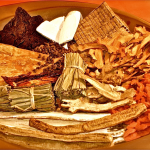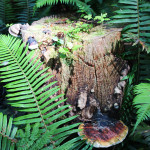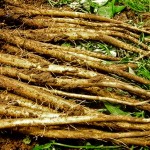
Taoists observe that trees are tremendously powerful plants. Not only do they absorb carbon dioxide and transform it into oxygen, but they can also absorb negative forces and transform them into good Qi. Trees strongly root within Earth, and the more rooted the tree, the higher it can extend toward Heaven. Trees stand in stillness, absorbing the Earth’s energy and the Universal essence from the Heavens all at once. Trees and all plants have the ability to absorb light and transform it into food; in fact, they depend upon light for most of their nourishment, while water and earth minerals make up about 30% of their nutritional intake. 
Trees as Friends • Trees are able to live very long lives. Trees are the largest and most spiritually advanced of the plants on Earth. They are continuously in meditation and subtle energy is their innate language. As one’s understanding of this language grows, we begin to develop a relationship with these life forms. They can help us to open energetic channels and to cultivate calm presence, wisdom, and vitality. We can reciprocate with trees by helping them with their own blockages and devitalized areas. It is a mutually beneficial relationship that needs cultivation. 
Choosing a Tree to Work With • Throughout history human beings have used all parts of trees for healing and medicine. The best trees for healing are big trees, especially pines. Pine trees radiate Qi, nourish blood, strengthen nervous system, and contribute to long life. They also nurture Soul and Spirit. Pines are the “Immortal Tree.” Early Chinese poetry and painting is full of admiration for pines. Although pine trees are often the best choice, many other trees or plants can be used. The larger trees contain the most energy. Among the most powerful are trees growing near running water. Some trees feel warmer or hotter than others; some feel cooler or colder than others. Practice distinguishing the varying properties of different trees. One does not need to go far out into the forest to find a tree to work with. Trees that are accustomed to having people around understand our Energy and are actually more accessible and friendly than those far out in the wilderness. There is a certain size range within which trees are most accessible to human beings. When a tree is too small, it does not have enough energy to make much of an impression on you. When the tree is too big, you have the opposite problem, so it takes more persistence to get large trees to take an interest in you. As a source of healing energy, it is best to choose a large, robust tree from within the accessible size range. 
Establishing Communion with a Tree • There are certain methods to approaching, interacting with, retreating from, and taking leave of a tree. By following specific steps you create a ritual of silent communion that both the tree and oneself can understand, and so increase the potential for harmonious interaction. The steps were derived from observation of the natural course of events in subtle energy communion, and apply to communion with just about anything: tree, rock, human, or animal, although the following is concerned specifically with trees. First of all, each tree, like each person, has a way of being, desires, and a Life of its own. Trees differ widely in their taste for human contact. Some are very generous and want to give you all the energy you can take. Others are weak or ill and need your comforting and healing energy. Some are just friendly Souls who enjoy human company. You can learn and grow by working with all of them. Trees operate on a longer time scale than do human beings. You can help to bridge this gap by returning again and again to the same tree, so that a relationship develops. Visit regularly so that the tree knows when to expect you and can look forward to seeing you. Spiritual communion with trees resembles love more than any other human activity. Let the tree lead you into the wonders of its own inner life. 
Cultivate Well-Being &
Wellness for All Beings!





